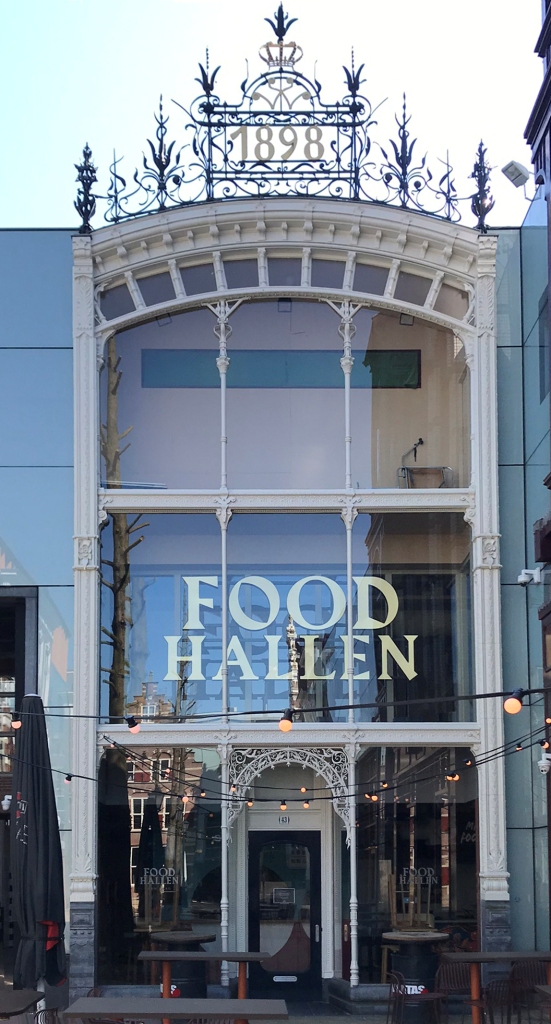Nowadays, we are no longer surprised by buildings made of iron or steel and glass. But in 1898, when Egbertus Beekman had the premises of his hardware shop at number 56 Denneweg completely renovated, he enriched The Hague with what is still an extraordinary building.
Beekman Company
Egbertus Beekman started a simple forge on Denneweg in 1876, which soon expanded. Not only did his own production increase, he also started a trade in English, French and German ironmongery. In 1882, he applied for a licence to expand his business to the rear with premises that extended to Nieuwe Schoolstraat. He also gained an entrance there with house numbers 21, 23, 25 and 43.
Just a jump ahead: The warehouses at 21 and 23 were given a special purpose in 1964. They were turned into the small theatre Pepijn, which is still an indispensable part of The Hague’s cultural facilities.
Extensive renovation
In 1898, the firm had the building on Denneweg completely renovated. The following text can be found in the newspaper the Avondpost of 3 October 1898: “The energetic owner wants to make his business the first in its field, and to this end a huge renovation was started in the spring, as a result of which the stove warehouse has become an establishment such as one would be hard pressed to find a second one in the Netherlands and Belgium. At present, everything is not yet ready, yet the beautiful, peculiar façade already attracts the attention of all passers-by. No less than 45,000 kilos of iron were used as material in the conversion, most of which was processed under the owner’s supervision in his own factory, which is a testament to the height at which it stands.”
The Beekman firm placed a large advertisement in the Haagsche Courant for the reopening of the premises, proudly mentioning the “Reopening of the all-new household goods and building materials warehouses furnished to the standards of the time”.
The architect and the design
The architect of the renovated building was Jan Willem Bosboom. For most of his career, he had mainly designed buildings in the neo-Renaissance style, but for the Denneweg 56 building, he took a very different approach. Above the ground floor, it is one large space, with galleries on two levels”. Galleries as in a theatre. Most importantly, Bosboom designed a whole new facade, of ornamental cast iron with huge glass windows unusual for the time.
Topping the building
The year 1898 was not only important for the Beekman firm. Queen Wilhelmina was also entering a new phase in her life. She turned 18 that year and was inaugurated at the Nieuwe Kerk in Amsterdam on 6 September, barely a month before the opening of Beekman’s new premises. Egbertus Beekman was apparently a fan of the House of Orange, as he linked the two events in the decoration of his new showrooms. He applied a crowning touch, quite literally. On Denneweg, look up closely at the top of the facade, and you will see beautiful ironwork,a copper crown, the year 1898 and a W, obviously the first letter of Wilhelmina.
Incidentally, the crown and the W were removed by order of the Germans during World War II. All street names of and other references to still-living members of the Royal Family were banned during the occupation. As were names of Jewish people. After the war, the facade was restored.
The building
In 1926, the Beekman firm celebrated its 50th anniversary with a reception in the beautiful premises on the Denneweg, unfortunately Egbertus Beekman died at the end of that year at the age of 77. His sons continued the business. That went well until an advertisement appeared in the Binnenhof in September 1953: “Liquidation sale due to death”.
The building then became the showroom of the furniture factory KEMBO, a company that exists today. Their well-known designer-consultant W.H. Gispen adapted the interior to display the furniture he designed. From 1957, the Hague branch of KEMBO was renamed Al-Veka (short for Algemeen Verkoopkantoor).
Many The Hague residents will know the building mainly as a film arthouse, because that is what it was from 1981 to 1991.
A copy of the facade was made for the Haagsche Bluf shopping district, which opened in 2001.
Colour difference
The facade of the original on Denneweg is now black, or perhaps I should say anthracite. The facade in the Haagse Bluf is painted white. It is difficult to determine what the original colour was in 1898, because the oldest colour image I could find is a photo from 1967 in the Hague Municipal Archives. In this photo, the building is white and in a photo from 2009, the facade is black.
Whatever the case with those colours, we can admire this remarkable building in two places in The Hague. And from Saturday 8 to Monday 10 June 2024, you can enjoy much more Art Nouveau in The Hague. Because that is when the annual ART NOUVEAU FESTIJN takes place. During this event, you can take part in walks, bicycle tours, workshops and lectures. And visit exhibitions. All information is available at: www.artnouveaufestijn.nl






